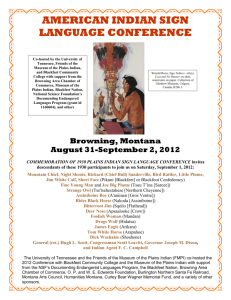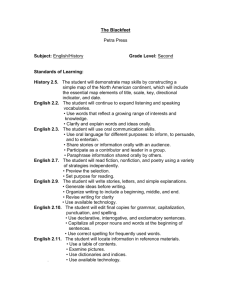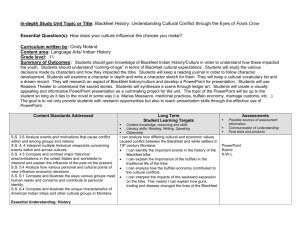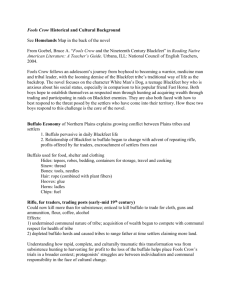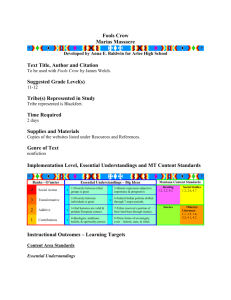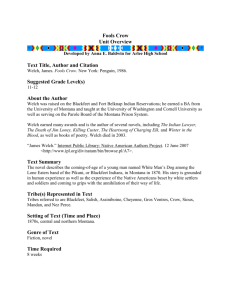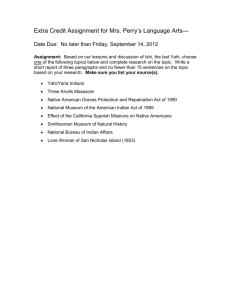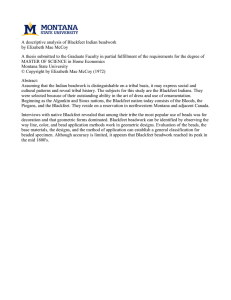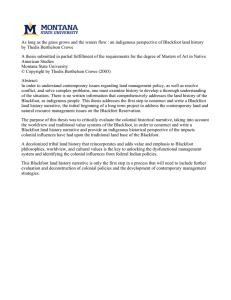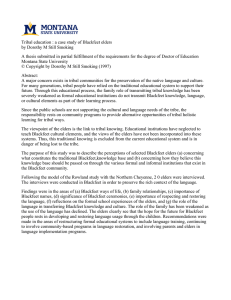Blackfeet Text Study - Arlee Joint School District No. 8
advertisement
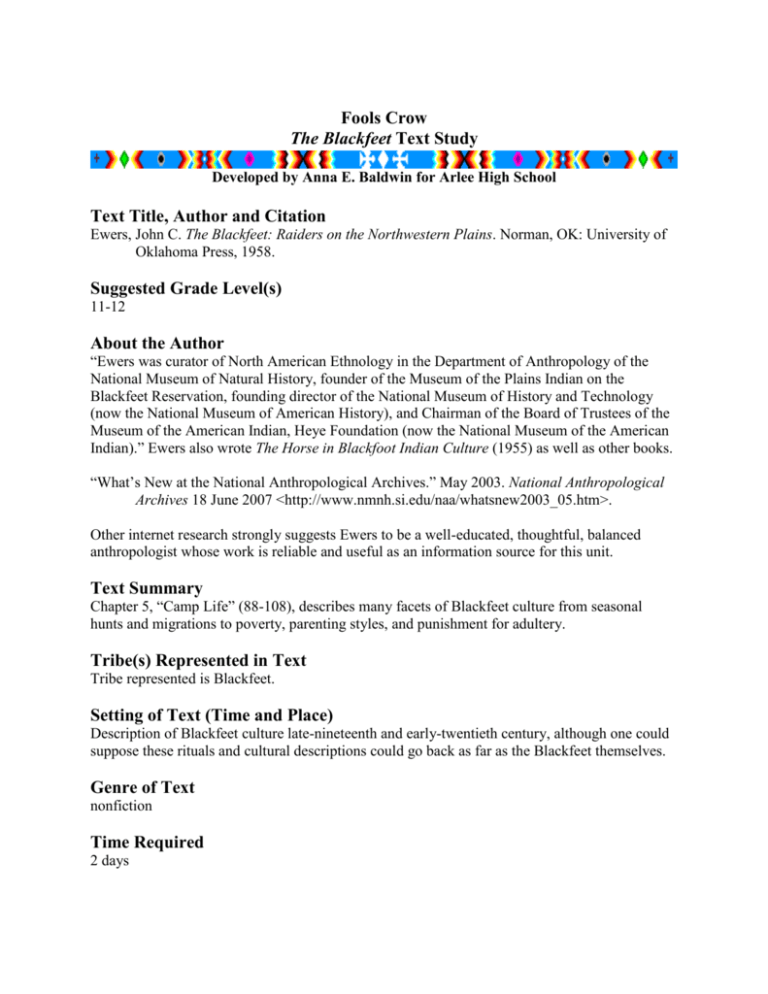
Fools Crow The Blackfeet Text Study Developed by Anna E. Baldwin for Arlee High School Text Title, Author and Citation Ewers, John C. The Blackfeet: Raiders on the Northwestern Plains. Norman, OK: University of Oklahoma Press, 1958. Suggested Grade Level(s) 11-12 About the Author “Ewers was curator of North American Ethnology in the Department of Anthropology of the National Museum of Natural History, founder of the Museum of the Plains Indian on the Blackfeet Reservation, founding director of the National Museum of History and Technology (now the National Museum of American History), and Chairman of the Board of Trustees of the Museum of the American Indian, Heye Foundation (now the National Museum of the American Indian).” Ewers also wrote The Horse in Blackfoot Indian Culture (1955) as well as other books. “What’s New at the National Anthropological Archives.” May 2003. National Anthropological Archives 18 June 2007 <http://www.nmnh.si.edu/naa/whatsnew2003_05.htm>. Other internet research strongly suggests Ewers to be a well-educated, thoughtful, balanced anthropologist whose work is reliable and useful as an information source for this unit. Text Summary Chapter 5, “Camp Life” (88-108), describes many facets of Blackfeet culture from seasonal hunts and migrations to poverty, parenting styles, and punishment for adultery. Tribe(s) Represented in Text Tribe represented is Blackfeet. Setting of Text (Time and Place) Description of Blackfeet culture late-nineteenth and early-twentieth century, although one could suppose these rituals and cultural descriptions could go back as far as the Blackfeet themselves. Genre of Text nonfiction Time Required 2 days Supplies and Materials Copies of chapter 5, “Camp Life” (88-108) from The Blackfeet: Raiders on the Northwestern Plains. Map of Montana with geographical features. Implementation Level, Essential Understandings and MT Content Standards Banks - O’meter Essential Understandings – Big Ideas 1-Diversity between tribal groups is great. 5-History represents subjective x experience & perspective. 4 Social Action 3 Transformative x 2-Diversity between individuals is great. 6-Federal Indian policies shifted through 7 major periods. 2 Additive x 3-Oral histories are valid & predate European contact. 7-Tribes reserved a portion of their land-base through treaties. 1 Contributions 4-Ideologies, traditions, beliefs, & spirituality persist 8-Three forms of sovereignty exist – federal, state, & tribal. Montana Content Standards Reading 1.1, 1.4, 1.5, 2.4, 2.8, 5.4 Science Social Studies 1.1, 3.2, 4.7, 5.4, 6.4, 6.5 Other(s) Instructional Outcomes – Learning Targets Content Area Standards Essential Understandings Essential Understanding 2: There is great diversity among individual American Indians as identity is developed, defined and redefined by many entities, organizations and people. There is a continuum of Indian identity ranging from assimilated to traditional and is unique to each individual. There is no generic American Indian. Essential Understanding 3: Each tribe has its own oral history beginning with their origins that are as valid as written histories. These histories pre-date the “discovery” of North America. Essential Understanding 5: History is a story and most often related through the subjective experience of the teller. Histories are being rediscovered and revised. History told from an Indian perspective conflicts with what most of mainstream history tells us. Social Studies Students will 1.1 analyze and adapt an inquiry process (i.e., identify question or problem, locate and evaluate potential resources, gather and synthesize information, create a new product, and evaluate product and process). 3.2 differentiate and analyze the relationships among various regional and global patterns of geographic phenomena (e.g., land forms, soils, climate, vegetation, natural resources, population). 4.7 analyze and illustrate the major issues concerning history, culture, tribal sovereignty, and current status of the American Indian tribes and bands in Montana and the United States (e.g., gambling, artifacts, repatriation, natural resources, language, jurisdiction). 5.4 compare and contrast how values and beliefs influence economic decisions in different economic systems. 6.4 evaluate how the unique characteristics of American Indian tribes and other cultural groups have contributed to Montana’s history and contemporary life (e.g., legal and political relationships between and among tribal, state, and federal governments). 6.5 analyze the conflicts resulting from cultural assimilation and cultural preservation among various ethnic and racial groups in Montana, the United Sates and the world. Skill Sets Reading Students will 1.1 make predictions and describe inferences and connections within material and between new material and previous information/experiences. 1.4 demonstrate understanding of main ideas and formulate arguments using supporting evidence. 1.5 accurately paraphrase reading material, reflecting tone and point of view. 2.4 use features and organization of fiction and nonfiction materials to comprehend increasingly complex material (e.g., paragraphs, chapters, titles, indexes, tables of contents, graphs, charts, visuals, and methods of organization). 2.8 ask questions, check predication, summarize, and reflect on information to monitor progress while taking responsibility for directing one’s own reading. 5.4 analyze use of evidence, logic, language devices, and bias as strategies to influence readers. Learning Experiences – Text-Based Inquiry Unit Essential Question for this unit: What are some essential things to know about migrations and hunting, politics, marriage, parenting, and relationships in the Blackfeet culture? Before – Day One Brainstorm as a class: This chapter’s title is called “Camp Life.” What topics do you expect to be covered? Put them into a question form. Note to teacher: the questions you want should include the subtopics in the Essential Question above: migrations and hunting, politics, marriage, parenting, and relationships. So you should end up with some questions like, “What patterns of migration did the Blackfeet follow?” “What kinds of marriages did they have and allow?” and so forth. Have students copy these questions onto the left side of a double-column chart. There should be ample space between questions so they can answer the questions on the right, as they read. During – Day One 1. As a class, read the first paragraph. Have a student mark on the map with pushpins the boundaries of the Blackfeet territory as listed in the book. Remind them, to what year is this referring? What do they know about current Blackfeet territory? (The reservation might even be marked on them map for them to see as a comparison.) 2. Guide students to read the first sentence of the next paragraph: “The Blackfoot Indians’ year was divided into four seasons of unequal length.” From a reader’s perspective, what clue is the writer giving you about his organization for this section of the chapter? (Answer: he is going to describe the 4 seasons.) From a note-taker’s perspective, what should you do about your migration question? (Answer: don’t write anything down until you’ve read the whole section about all four seasons so you don’t write the wrong thing or too much.) 3. Have students read the whole section individually about the annual cycle, which ends at the top of page 92 and is signaled by the paragraph beginning “Thus the annual cycle of camp movements varied with the seasons” on page 91. 4. As a group, what are the most important ideas to write about migration and hunting? 2-3 sentences, maximum. Discuss the importance of “getting the gist”: they don’t need to write every detail! 5. Homework: read the rest of the chapter, filling in the chart by repeating the same process: find the beginning and end of each section or subtopic, read, and THEN take notes. During – Day Two 1. Entry ticket: Have students write one interesting fact they learned from last night’s reading and one question they have about last night’s reading. 2. In pairs, have students compare their notes. Did they get the same information? While students are doing this, you can look through their entry tickets to use some of the facts/questions as discussion topics and questions. 3. Discuss as a whole group: What notes did you take to answer each question? What main ideas did you note? If you sense they have a good grasp, don’t bother making a giant model for them to compare/copy. If they don’t, you might make a model of some of the chart as you see how it should be completed with the information you think students should have. 4. Discussion: use their entry tickets to facilitate discussion about the reading. If you have persistent problems getting students to do their homework, now is a good time to administer a quiz. You’ve already discussed some of the more important ideas, so you might ask some questions from the text that you didn’t cover, like “What were two of the women’s jobs at the end of a march?” “Why did the families erect their lodges close to their chief’s lodge?” “What was one way besides cutting hair that Blackfeet expressed grief?” If they read carefully, students should remember the answers to these questions. After At the end of the note-taking/comparing session, you might ask students to do one of a number of final “exit activities”: Write something that you find hard to believe from this chapter and explain. Word splash: verbally or on post-its, students offer words of summary for the reading. Journal: you are a Blackfeet (your age/gender) during one of the seasons described. Write a quick timeline of your day. Predict the future: what would be the greatest loss to the Blackfeet when they were put onto a reservation? Predict the novel: referring to at least one specific fact from the chapter, write a prediction for the novel Fools Crow. It could be a broad prediction (I think this book will be about…) or a more specific one: (I think that one event in this book will be…) Caution students not to fill in the end of the sentence with a single word or concept. While students read the novel, have them refer to this chapter and their notes. Much of what is described in the novel is directly related to the chapter’s information, even the photo at the end of the chapter. Teacher Notes and Cautions If you have Native American or Blackfeet students in your class, you might exercise caution with this chapter. Despite its authorship by a noted and respected anthropologist, some students might be offended by some of the harsher depictions of Blackfeet traditions and practices (for example, the description of what happened when people died without a will: people rushed to grab his things, leaving only the worst for the widow, or the photo at the end of the chapter). Allow ample opportunity for students to respond or refute. It will still be a useful chapter later on, when the novel describes migrations, polygamy, and other customs. At the very least you could say that this account and the novel match, even if both are somewhat inaccurate. At the most, you could have students conduct their own research into the topics they are interested in or suspicious about.
